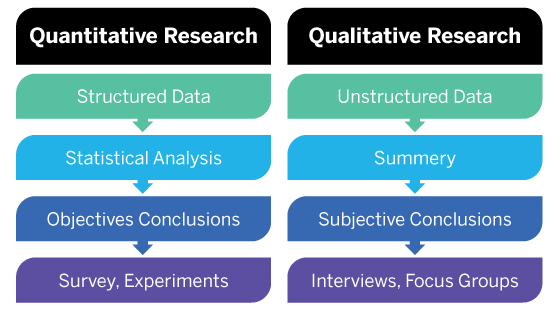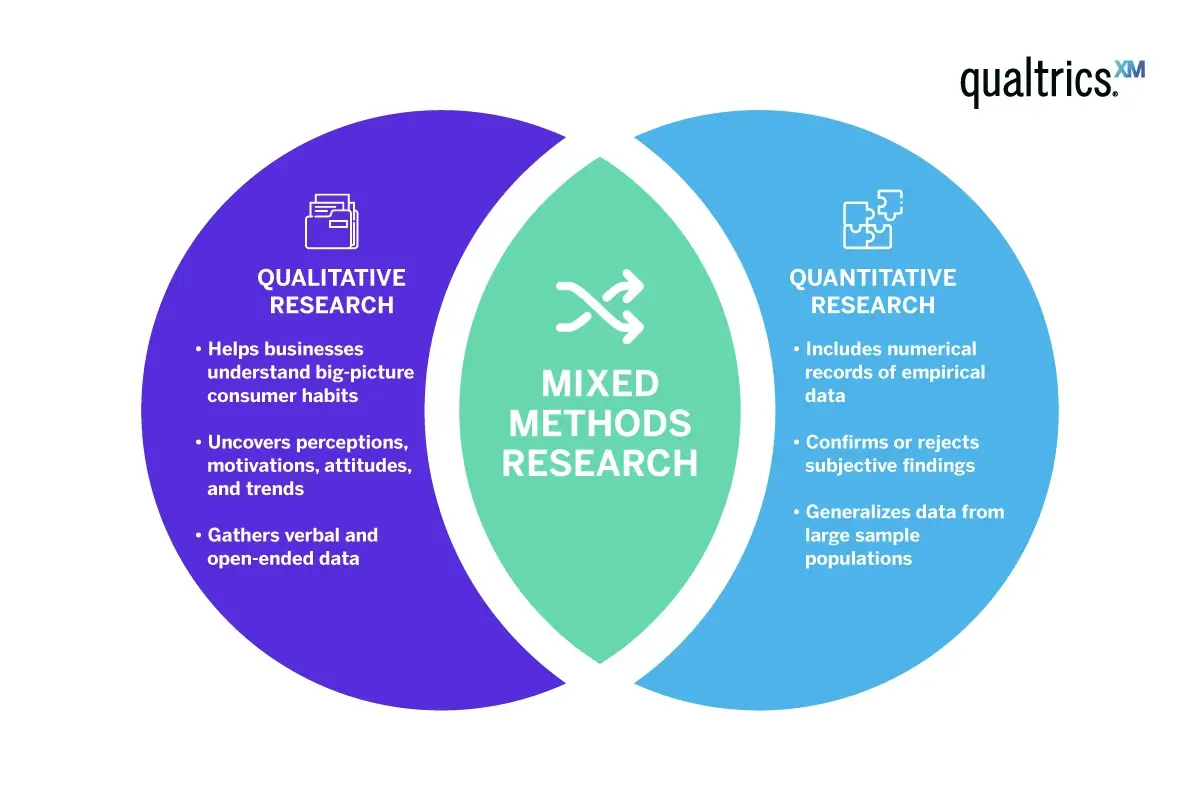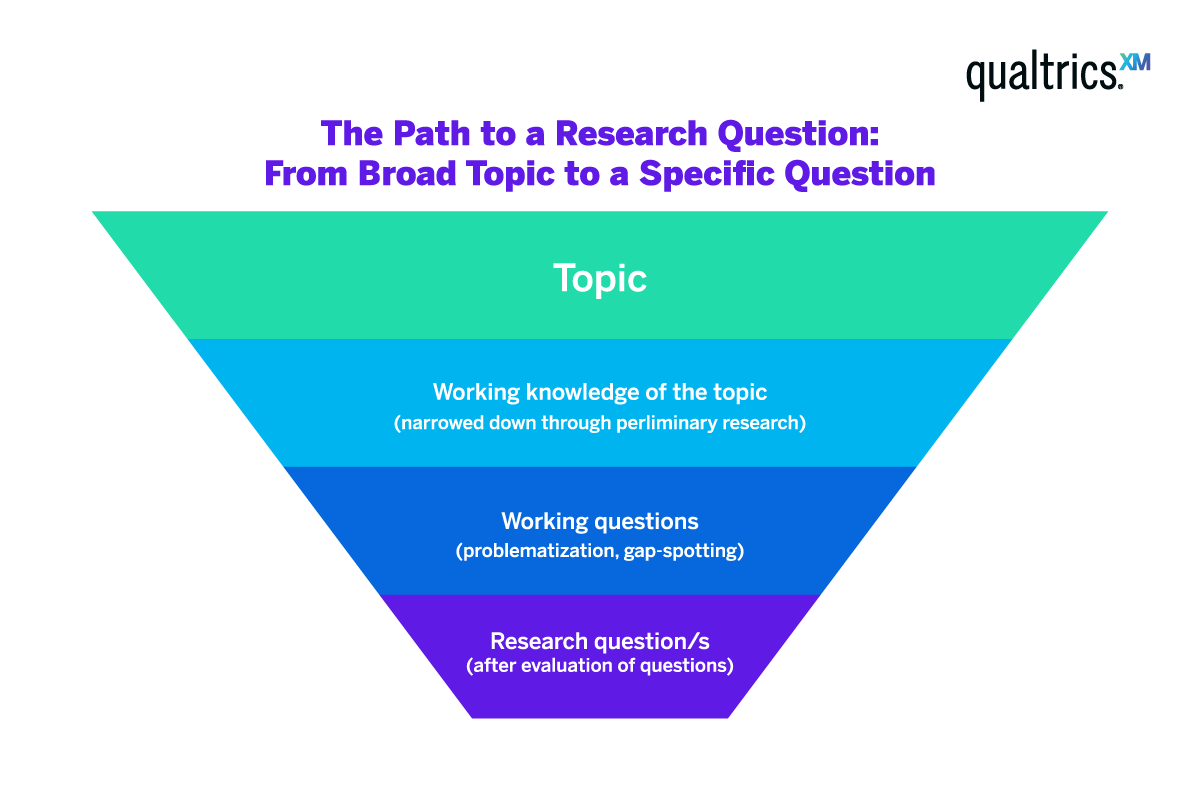Author: Will Webster
Subject Matter Expert: Emily Geisen
What is mixed methods research?
Mixed methods research is a powerful approach that combines both quantitative and qualitative research methods to gain a more comprehensive understanding of a topic.
While quantitative research focuses on numbers and statistical analysis, qualitative research dives into the experiences, opinions and motivations of people. By combining these two approaches, researchers can explore the “what” and the “why”, providing the best of both worlds to deliver richer insights than either method could alone.
This approach is particularly valuable when dealing with complex issues that can’t be fully understood through numbers or words alone. For instance, you might start with a survey to gather broad data on a population (quantitative), and then follow up with interviews or focus groups to explore deeper meanings and nuances (qualitative). By integrating these findings, you can cross-validate results and gain a more well-rounded understanding of the topic or problem you’re exploring.
Qualitative vs. quantitative research
To understand mixed methods studies, it’s crucial to first know the differences between qualitative and quantitative research.

Quantitative research is all about numbers and measurements. Leveraging tools like surveys, it deals with data that can be counted, categorized and statistically analyzed. This approach is great for answering questions like “how many?” or “what proportion?” – when you need to measure something precisely, test hypotheses or identify patterns across large groups.
On the other hand, qualitative research is more about exploring depth and meaning. Instead of numbers, it focuses on words, images and experiences – helping you understand the “how” and “why”. Leveraging methods like interviews, focus groups and open-ended surveys, it’s used when you want to dive deep into people’s thoughts, feelings or behaviors.
Integrating qualitative and quantitative methods
Crucially, in the context of mixed methods research, these two approaches are not in competition – they’re complementary.
Integrating both qualitative and quantitative methods isn’t just about using both approaches in the same study – it’s about strategically combining them in a way that each method enhances and informs the other.
There are several ways to integrate these methods – which we’ll come on to very soon. But no matter how they’re integrated, the goal of mixed methods research is to leverage the strengths of both qualitative and quantitative approaches.
When to use mixed methods research
Mixed methods research is a versatile approach that can be applied at various stages of your research process.
No matter if your goal is to explore a challenging issue, broaden the scope of your insights or dig deeper into your data, the aim is to use the right combination of methods throughout your entire research process to make well-rounded, informed decisions.
Let’s look at the core applications.
Throughout your research journey
Mixed methods research isn’t just a one-time tool – it’s a strategy that can be applied throughout the entire research journey.
Imagine you want to understand a new market or consumer behavior. In the beginning, you might rely entirely on qualitative methods, such as interviews or focus groups, to gather deep, rich insights. As your understanding deepens and you begin to form hypotheses, you can then transition to a more quantitative approach.
By moving from a qualitative study to a quantitative one, you’re not just validating your initial insights – you’re also generalizing them, making them actionable on a broader scale.
This approach is particularly useful for businesses – especially when research is one of many tasks being juggled. It allows you to adapt your research methods over time, aligning them with the evolving needs of your project and the decisions you need to make. Rather than trying to capture everything in a single study, you can spread your research across multiple phases, using the strengths of each method where they’re most needed.
Tackling complex research questions
Complex research questions often require a multi-faceted approach to capture all the relevant dimensions. Mixed methods research excels here by allowing researchers to tackle complexity head-on, with its dual approach ensuring that no aspect of the research question is overlooked.
For instance, you can use qualitative methods to identify the underlying factors of a complex issue, then apply quantitative methods to measure the extent of those factors across a broader population.
Generalizing and expanding qualitative findings
Often it’s not enough to simply understand a topic on a deep level – you also need to know its breadth and how it may apply to a larger audience. This is again where mixed methods research shines.
After gathering in-depth qualitative insights, mixed methods research allows you to use quantitative techniques to test these insights across a broader group – helping you generalize your findings, making them more actionable and relevant to a wider audience.
Explaining quantitative results
Mixed methods research allows you to dig deeper into quantitative results by adding a qualitative layer of understanding. Because while numbers can tell you a lot, they don’t always give the full story.
For instance, if your quantitative data reveals a surprising trend, qualitative methods can help you explore the reasons behind it, helping you explain and contextualize your data. With a mixed methods approach, you can ensure that your quantitative insights aren’t just statistically significant, they’re also both meaningful and relevant.
Benefits of mixed methods research
Mixed methods research brings together the best of both quantitative and qualitative approaches, offering a range of benefits that make it an ideal choice for any researcher or business looking for comprehensive insights.

By integrating these methods, you can ensure that your research is not only thorough but also adaptable to the evolving needs of your projects.
Triangulation and validation
One of the standout advantages of mixed methods research is the ability to triangulate and validate your findings. By using both quantitative and qualitative data, you can cross-check your results, ensuring they hold up under different lenses to strengthen the credibility of your conclusions.
In practice, having all your data in one place simplifies this validation process. Doing everything within a single platform, like Qualtrics® XM for Strategy and Research™, makes it easier to compare and contrast findings – ensuring that your insights are well-rounded and reliable without the need for complex data management.
Holistic insights and context
Mixed methods research excels at providing holistic insights.
Quantitative data gives you the big picture; qualitative data fills in the gaps. This combination results in a richer, more nuanced understanding of your research subject.
When all your data is accessible and integrated, drawing connections between the broader trends and the detailed stories becomes more straightforward, empowering you to build a more complete and contextually rich narrative to help you make more informed decisions.
Flexibility in research design
Mixed methods research is flexible by definition – allowing you to adapt your research design as new questions or challenges arise.
Whether you start with a qualitative exploration to define the scope of your research, or you begin with quantitative analysis and follow up with qualitative methods to delve deeper, this flexibility is especially beneficial in fast-paced environments where the ability to pivot quickly can be a huge competitive advantage.
A single platform that supports both quantitative and qualitative research enhances this flexibility. With the right tool you can easily switch between methods, integrate new data and refine your approach without having to juggle multiple tools or platforms.
With a single platform you’re not only saving time, you’re also ensuring that your research remains cohesive and aligned with your overall objectives.
Types of mixed methods research designs
Mixed methods research isn’t a one-size-fits-all approach; there are several designs you can choose from depending on your research goals and the nature of your study.
Each design offers a different way to integrate quantitative and qualitative methods, allowing you to tailor your research process to best address specific questions or topics.
Let’s look at three of the most commonly used mixed methods research designs.
Convergent parallel design
The convergent parallel design is one of the most straightforward mixed methods approaches.
In this design, quantitative and qualitative data are collected simultaneously but analyzed separately. The key is to give both sets of data equal priority, bringing them together during the interpretation phase, before then comparing and contrasting the results to see where they converge or diverge.
This design is particularly useful when you want to verify findings and gain a more comprehensive understanding of the topic. For example, you might use quantitative surveys to gather broad data on customer satisfaction while conducting interviews to explore the reasons behind the survey responses.
Explanatory sequential design
In the explanatory sequential design, research begins with quantitative data collection and analysis, followed by qualitative methods to explain or build on the quantitative results. This design is especially useful when you have clear quantitative findings that require further exploration to understand their underlying reasons.
For instance, imagine you conduct a survey that reveals a significant drop in employee engagement. While the quantitative data shows the trend, it doesn’t explain why this drop is happening. So, you follow up with in-depth employee interviews to explore the factors contributing to the decline.
Exploratory sequential design
The exploratory sequential design flips the order of the explanatory sequential design. Here, you start with qualitative data collection to explore a topic, and then follow up with quantitative methods to test and validate those initial insights.
This design is ideal when you’re entering a research area where little is known, or when you need to develop a framework or theory that can later be tested.
For example, if you’re launching a new product and want to understand potential customer needs and preferences, you might begin with focus groups or interviews – helping you identify key themes and variables. Once you have a clearer picture, you can design a quantitative survey to test these themes on a larger scale to ensure that your findings are broadly applicable to your audience.
Mixed methods research in action
Let’s take a look at how mixed methods research can be applied in the real world.
A fintech company is working to design a user-friendly mobile banking app that enhances its customer experience – for both tech-savvy users and people who may be less familiar with digital banking – while meeting stringent regulatory requirements.
To achieve this – and create a mobile banking app that’s both user-centered and well-grounded in data – the company employs a mixed method approach, leveraging quantitative and qualitative methods across several phases.
Phase 1: Foundational research
To start, the company conducts in-depth interviews with potential users to uncover their needs, challenges and preferences, and shape the initial direction of the app. Alongside this, a quantitative market analysis is performed to understand broader trends and competitor offerings.
The combination of these methods gives the company a well-rounded view of both user expectations and its market landscape. The company uses this information to come up with a detailed concept for their digital banking app.
Phase 2: Concept testing
Next, the company tests its initial app concepts.
It deploys focus groups to gather qualitative feedback, helping the team refine ideas based on user reactions. To validate these insights, a concept testing survey is conducted with a larger user base, helping the team understand which concepts are most appealing.
Phase 3: Prototyping and usability testing
As the app design progresses to the prototyping stage, the fintech company uses unmoderated user testing to see how users interact with the prototype. This feedback reveals usability issues and helps refine the design.
At the same time, usability metrics – such as task success rates and time on task – are tracked to quantitatively measure the app’s performance.
This process is iterative, they revise the prototypes based on feedback and test again to make sure the changes improve users’ experiences with the app.
Phase 4: Launch and initial monitoring
At the app’s launch, the company closely monitors user interactions through usage analytics, providing quantitative insights into how the app is being used – and where that usage leads to frustration like rage clicks. To complement this data, user feedback sessions gather qualitative insights directly from users to better understand the cause of the frustration.
This combination allows the company to quickly identify and address any issues, ensuring a smooth user experience from the start.
Phase 5: Continuous improvement
Post launch, the company moves into the continuous improvement phase to ensure that the app evolves with user needs and stays competitive in the market.
Digital customer satisfaction and NPS surveys are regularly used to collect quantitative data on user satisfaction and loyalty. Alongside these efforts, the company engages with users in online communities to gather qualitative feedback on their experiences and suggestions.
How to conduct effective mixed methods research
Great mixed methods research requires careful planning and execution at every stage.
By following a structured approach, you can ensure that your research delivers comprehensive, actionable insights.
Here are the three main areas to get right.
Defining research questions
The first step in any research project is defining clear and focused research questions. In mixed methods research, it’s vital that you work around research questions that can be answered using both qualitative and quantitative methods.
Start by considering what you want to learn and how each method can contribute to answering your questions. For instance, you might use quantitative methods to measure the extent of a problem and qualitative methods to explore the underlying causes.

Choosing the right design
Once your research questions are defined, the next step is choosing the right mixed methods design.
Whether you opt for a convergent parallel design, an explanatory sequential design or an exploratory sequential design really depends on your specific research goals.
Here, think about how you want to integrate the qualitative and quantitative data. Do you want to collect them simultaneously or sequentially? Which method will take precedence?
Integrating and interpreting data
The true power of mixed methods research lies in the integration and interpretation of your data.
After you’ve collected your data, the challenge is to bring it all together in a meaningful way. Look for points of convergence where the data supports the same conclusions, as well as areas where the results diverge.
The use of a single platform can make a big difference during this phase – especially one that offers data integration and analysis. By having all your data in one place, you can compare and contrast findings with far greater ease – leading to richer interpretations and more robust conclusions a lot faster.
Discover how Qualtrics simplifies mixed methods research
Today’s leading organizations are leveraging mixed methods research to gain deeper insights, validate hypotheses and seamlessly incorporate findings into every phase of business building – from creating productive, cohesive teams, to developing game-changing products.
Download the free Qualtrics ebook today to learn how you can enhance and combine your research capabilities to drive meaningful change across your organization.
This comprehensive guide will show you how to future-proof your surveys, leverage AI-powered tools to save time and money and make qualitative analysis more efficient than ever before.
Free eBook: Breaking down silos: Combining qualitative and quantitative research